The other day, we invited our good friends over for a holiday dinner that started with Champagne, oysters, and foie gras. For the occasion, our friend Rick had brought a bottle from his magnificent wine collection, a 1996 Château Pontet Canet that we opened with the main dish, a chicken roasted with chestnuts.
Château Pontet Canet is a Fifth Growth estate located in the northern end of the Pauillac commune, across the road from Château Mouton Rothschild. It has 80 hectares of vineyards, planted with 60% Cabernet Sauvignon, 33% Merlot, 5% Cabernet Franc and 2% Petit Verdot. The average age of the vines is 35 years.
The wine was simply outstanding. It was medium red in color with a multi-layered nose of blackberry aromas and gamey notes. On the palate, it was intense and luscious with a long finish dominated by licorice. Purely enchanting.
I am afraid the magnum of 1998 Silverado Vineyards Cabernet Sauvignon Stags Leap District that I opened later didn't stand comparison with the Pauillac. But the company was merry and nobody cared.
Happy new year!
Technorati tags: wine food & drink
The smell of wine, oh how much more delicate, cheerful, gratifying, celestial and delicious it is than that of oil. François Rabelais (1495-1553)
Saturday, December 29, 2007
Thursday, December 20, 2007
Forget the Winter Reds, try this delicious California White
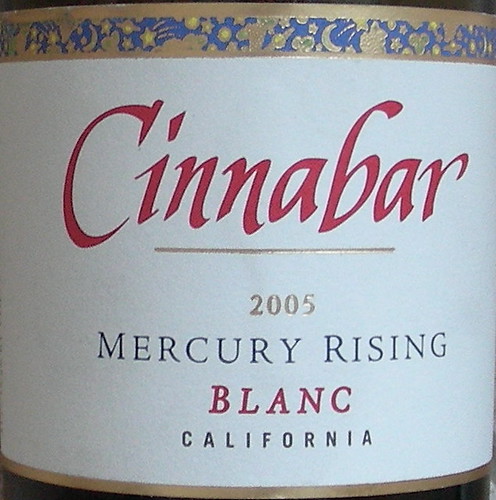 The wine departments of our local grocery stores are getting more and more interesting. You can now find wines from many regions around the world and at the same time, there is often a shelf dedicated to wines made by local wineries. So the other day, I found a 2005 Cinnabar Mercury Rising Blanc at my local Mollie Stone's Market. I already had the Mercury Rising Red — a Bordeaux-style wine — several times, and I was curious to try the white version.
The wine departments of our local grocery stores are getting more and more interesting. You can now find wines from many regions around the world and at the same time, there is often a shelf dedicated to wines made by local wineries. So the other day, I found a 2005 Cinnabar Mercury Rising Blanc at my local Mollie Stone's Market. I already had the Mercury Rising Red — a Bordeaux-style wine — several times, and I was curious to try the white version.Located high on a ridge in the Santa Cruz Mountains, Cinnabar Vineyards & Winery was founded by Tom Mudd, a Stanford grad and research engineer at SRI International (Stanford Research Institute). But after planting a one-acre mountain vineyard in 1974, he decided to change careers, took viticulture and enology courses at the University of California Davis, and finally founded his own winery in 1983.
He chose the name Cinnabar, a brick-red mineral (mercury sulfide) that fascinated the alchemists of the Middle Ages. They would crush and heat up a piece of cinnabar and observe the mercury separate from sulfur and evaporate. Using a similar process, they were hoping to find a way to extract gold and silver from any ordinary metal.
Mercury Rising Blanc is Cinnabar's proprietary white. It is a blend of Sauvignon Blanc, Viognier and Sémillon, sourced in 2005 in Monterey County, Sonoma County and Clarksburg. We opened the wine at a recent holiday potluck lunch where people had brought different ethnic dishes. The wine ended up being very popular. In the glass, it displayed a pale yellow color and a fresh nose of citrus. There was some tangy acidity on the palate followed by lime flavors and minerality on the finish. The wine worked beautifully with the ethnic food, especially the Sashimi salad made with raw flounder and brought by our Japanese friend Misako.
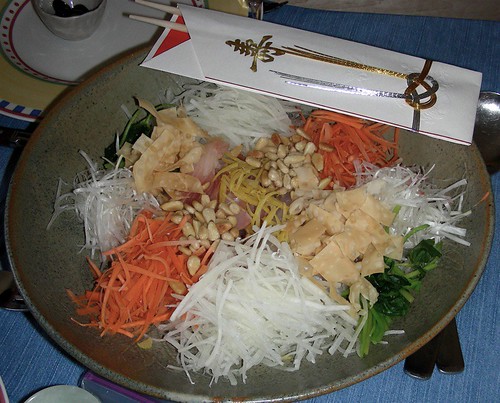
Misako's sashimi salad
Technorati tags: wine food & drink
Wednesday, December 12, 2007
4th Annual Menu for Hope: donate and win food and wine prizes
 Each year, food and wine bloggers from all over the world join forces to promote the Menu for Hope initiative and donate a wide selection of wonderful food and wine related prizes.
Each year, food and wine bloggers from all over the world join forces to promote the Menu for Hope initiative and donate a wide selection of wonderful food and wine related prizes. Menu for Hope is essentially an online raffle with prizes donated by bloggers. For every US$10 they donate, participants receive a virtual raffle ticket toward a prize of their choice. In 2006, Menu for Hope successfully raised US$60,925.12 to help the UN World Food Programme feed the hungry.
This year, Menu for Hope is again supporting the UN World Food Programme and more specifically, the school lunch program in Lesotho, Africa. This program not only keep these children alive but also help them stay in school so that they can learn the necessary skills to feed themselves in the future. This is also a model program in local procurement - buying food locally to support local farmers and the local economy.
Now, how can you help? it is very easy: go to the donation site at Firstgiving and make a donation. Make sure you read the instructions regarding your choice of prize(s). This year, Purple Liquid will donate a Santa Cruz Mountains Wine Sampler, 6 wines from the Santa Cruz Mountains, a world-class wine producing region and home to some of the oldest wineries in California. Use code WB25 for this prize but before that, make sure I can ship the wine to you: the wine can only be shipped to the following states: Alaska, Arizona, California, Colorado, District of Columbia, Hawaii, Idaho, Illinois, Iowa, Louisiana, Missouri, Nebraska, Nevada, New Mexico, New York, North Dakota, Oregon, Texas, Washington, West Virginia, and Wisconsin.
I hope you will be the lucky person I will ship my prize to.
Technorati tags: wine food & drink
Friday, December 07, 2007
Tasting the wines of South America
The wines from South America was the theme of our last wine club tasting event. The selection included three wines from Argentina and four from Chile. The overall impression of the tasting was that many of the wines were big and some rather high in alcohol. These wines were also highly rated by wine critics —six out of seven were rated 90 points and above — showing that these South American wineries had been successfully positioning themselves for the American/European market.
Argentina
Although Argentina is one of the world's top five largest wine producing countries, quality-focused winemaking in Argentina has a young history. Not so long ago, most of Argentina's production was aimed at the local market. However, economic stability over the past decade has encouraged substantial investment — especially from foreign countries — and quality has drastically improved.
In Argentina, the winemaking region spreads along over 2,400 km at the foothills of the Andes. The region is dry and arid, a semi-desert with a wide thermal amplitude between day and night. Irrigation is essential and comes from the melting snow of the Andes. Here, altitude is one of the key factors to growing quality wine grapes. Vineyards are planted at between 2,500 and 5,000 feet to exploit cooler temperatures.
Chile
According to Chilean winemakers, “Chile is a paradise to grow grapes”. Wine has been made in Chile for centuries thanks to a unique combination of climatic and geographical conditions. Chile's wine regions are located in the broad valleys that lie against the Andes Mountains. In these valleys, the climate is generally hot and dry, although always balanced by cooling influences from the cold Pacific Ocean that is rarely more than 80km away.
Thanks to the Andes Mountains, a natural barrier against the invasion of diseases, Chile has never been attacked by the root louse Phylloxera. Therefore, vines can safely grow on their own roots. They can be planted by simply sticking cuttings into the ground without the burden and expense of grafting them on to resistant rootstock.
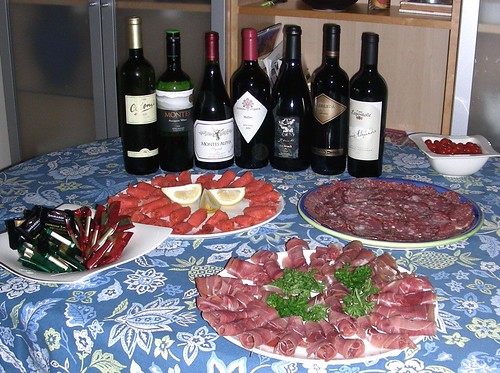
The wines we tasted:
 • 2006 Colomé Torrontés Salsa. Torrontés is Argentina's number one white variety although it is practically unknown in other parts of the world. It produces fragrant and fruity wines with crisp acidity and plenty of body. Bodega Colomé is situated at 7500 feet elevation in the Salta wine region near the base of the Andes and is actually the highest altitude winery in the world. Their Torrontès comes from 80-year-old vines farmed using biodynamic principles. My notes: extremely aromatic, a hint of sweetness, medium-bodied, reminded us of a Viognier.
• 2006 Colomé Torrontés Salsa. Torrontés is Argentina's number one white variety although it is practically unknown in other parts of the world. It produces fragrant and fruity wines with crisp acidity and plenty of body. Bodega Colomé is situated at 7500 feet elevation in the Salta wine region near the base of the Andes and is actually the highest altitude winery in the world. Their Torrontès comes from 80-year-old vines farmed using biodynamic principles. My notes: extremely aromatic, a hint of sweetness, medium-bodied, reminded us of a Viognier.
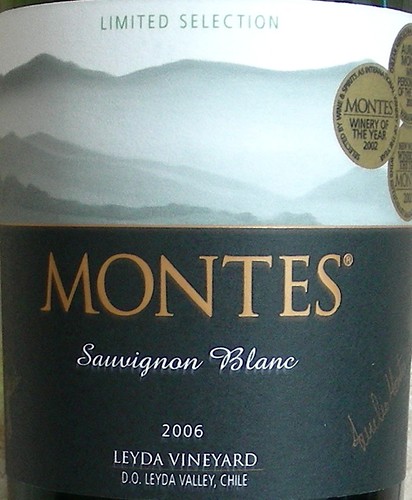 • 2006 Montes Sauvignon Blanc Leyda Vineyard: Viña Montes is a state-of-the-art winery from Chile that was founded in the late 1980s with the mission “to produce the best wines and continue opening markets and bringing the Chilean flag to all the world.”. Every bottle of wine is embossed with a seal that reads “From Chile with pride.” Today, over 90% of the wines from Montes are exported to over 70 different countries throughout the world. This Sauvignon Blanc comes from Leyda Vineyard located north of the Colchagua Valley and slightly cooler thanks due to its proximity to the Pacific Ocean. My notes: very fruity nose, aromas of citrus, crisp, pleasant.
• 2006 Montes Sauvignon Blanc Leyda Vineyard: Viña Montes is a state-of-the-art winery from Chile that was founded in the late 1980s with the mission “to produce the best wines and continue opening markets and bringing the Chilean flag to all the world.”. Every bottle of wine is embossed with a seal that reads “From Chile with pride.” Today, over 90% of the wines from Montes are exported to over 70 different countries throughout the world. This Sauvignon Blanc comes from Leyda Vineyard located north of the Colchagua Valley and slightly cooler thanks due to its proximity to the Pacific Ocean. My notes: very fruity nose, aromas of citrus, crisp, pleasant.
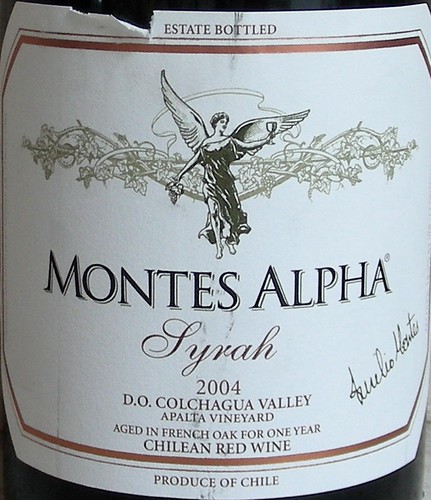 • 2004 Montes Alpha Syrah Apalta Vineyard: The Apalta Vineyard is located in Chile's Colchagua Valley at fairly high elevation, some 40 miles from the coast. The weather is characterized by warm and sunny days and very cool evenings. My notes: purple black color, ripe fruit aromas on the nose, thick, woody, and alcoholic on the palate. Overall, was found bold and for some, unbalanced.
• 2004 Montes Alpha Syrah Apalta Vineyard: The Apalta Vineyard is located in Chile's Colchagua Valley at fairly high elevation, some 40 miles from the coast. The weather is characterized by warm and sunny days and very cool evenings. My notes: purple black color, ripe fruit aromas on the nose, thick, woody, and alcoholic on the palate. Overall, was found bold and for some, unbalanced.
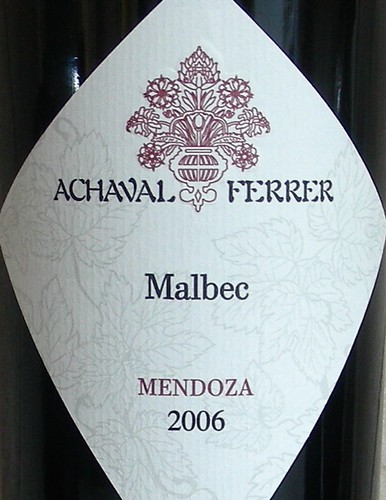 • 2006 Achaval Ferrer Malbec Mendoza: Achaval Ferrer is an Argentinean winery located in the Province of Mendoza, the country's largest wine region. The wine is 100% Malbec, Argentina's great red grape. Malbec is also one of the traditional Bordeaux varietals and the dominant red varietal in the Cahors appellation. Argentinian Malbecs are sometimes considered the best in the world. My notes: dark purple color, black fruit and pepper on the nose, some tannins and acidity on the palate. Nice yet not overly complex.
• 2006 Achaval Ferrer Malbec Mendoza: Achaval Ferrer is an Argentinean winery located in the Province of Mendoza, the country's largest wine region. The wine is 100% Malbec, Argentina's great red grape. Malbec is also one of the traditional Bordeaux varietals and the dominant red varietal in the Cahors appellation. Argentinian Malbecs are sometimes considered the best in the world. My notes: dark purple color, black fruit and pepper on the nose, some tannins and acidity on the palate. Nice yet not overly complex.
 • 2003 Tikal Patriota: from the Mendoza wine region in Argentina, this is a blend of Bonarda and Malbec. Unrelated to the Piedmont grape Bonarda Piemontese, Argentina's Bonarda may be the same grape as Charbono a variety of French origin and imported from California. Bonarda is today the second most widely planted grape variety in Argentina after Malbec. My notes: dark color, rich fruity flavors, well-balanced with some complexity. One of my favorite wines of the evening.
• 2003 Tikal Patriota: from the Mendoza wine region in Argentina, this is a blend of Bonarda and Malbec. Unrelated to the Piedmont grape Bonarda Piemontese, Argentina's Bonarda may be the same grape as Charbono a variety of French origin and imported from California. Bonarda is today the second most widely planted grape variety in Argentina after Malbec. My notes: dark color, rich fruity flavors, well-balanced with some complexity. One of my favorite wines of the evening.
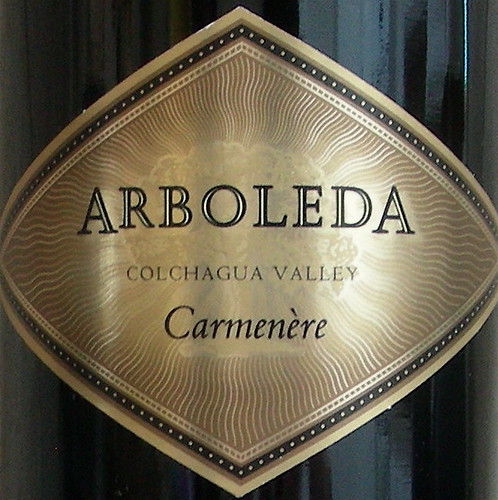 • 2005 Arboleda Carmenère: Also a traditional Bordeaux varietal, Carmenère is currently the rising star of the Chilean wine industry. Because of its susceptibility to mildew and pests, it is rarely used in Bordeaux anymore and as of today, Chile produces the vast majority of Carmenère wines with more than 4,000 hectares cultivated. Arboleda, which in Spanish means grove of trees, is a company founded in 1999 by Robert Mondavi and Eduardo Chadwick of Viña Errázuriz. My notes: deep color, aromas of black fruit and bittersweet dark cocoa, smoky, round mouthfeel, dusty finish. Another favorite of mine.
• 2005 Arboleda Carmenère: Also a traditional Bordeaux varietal, Carmenère is currently the rising star of the Chilean wine industry. Because of its susceptibility to mildew and pests, it is rarely used in Bordeaux anymore and as of today, Chile produces the vast majority of Carmenère wines with more than 4,000 hectares cultivated. Arboleda, which in Spanish means grove of trees, is a company founded in 1999 by Robert Mondavi and Eduardo Chadwick of Viña Errázuriz. My notes: deep color, aromas of black fruit and bittersweet dark cocoa, smoky, round mouthfeel, dusty finish. Another favorite of mine.
 • 2005 Casa Lapostolle Cabernet Sauvignon Cuvée Alexandre: The Marnier-Lapostolle family, creator of the Grand Marnier liqueur, founded Casa Lapostolle in 1994, purchasing an old wine estate in Chile's Colchagua Valley. The cuvée Alexandre is named after the owner's great-grandfather, Alexandre Marnier, who created Grand Marnier in 1880. It is a blend of 85% Cabernet Sauvignon, 15% Merlot coming from non irrigated 60 year old vines. My notes: deep red color, black berries on the nose, firm on the palate with tannins. Seems too young to be drunk now for my taste, should age a little bit longer.
• 2005 Casa Lapostolle Cabernet Sauvignon Cuvée Alexandre: The Marnier-Lapostolle family, creator of the Grand Marnier liqueur, founded Casa Lapostolle in 1994, purchasing an old wine estate in Chile's Colchagua Valley. The cuvée Alexandre is named after the owner's great-grandfather, Alexandre Marnier, who created Grand Marnier in 1880. It is a blend of 85% Cabernet Sauvignon, 15% Merlot coming from non irrigated 60 year old vines. My notes: deep red color, black berries on the nose, firm on the palate with tannins. Seems too young to be drunk now for my taste, should age a little bit longer.
Our next tasting event is our traditional end of the year Champagne tasting. We'll have a great selection of wines, mostly from small Champagne growers so don't miss it!
Previous wine club tastings:
• Tasting Summer Wines from around the Mediterranean Sea
• Guess the wine tasting
• Tasting the wines of Australia and New Zealand
Technorati tags: wine food & drink
Argentina
Although Argentina is one of the world's top five largest wine producing countries, quality-focused winemaking in Argentina has a young history. Not so long ago, most of Argentina's production was aimed at the local market. However, economic stability over the past decade has encouraged substantial investment — especially from foreign countries — and quality has drastically improved.
In Argentina, the winemaking region spreads along over 2,400 km at the foothills of the Andes. The region is dry and arid, a semi-desert with a wide thermal amplitude between day and night. Irrigation is essential and comes from the melting snow of the Andes. Here, altitude is one of the key factors to growing quality wine grapes. Vineyards are planted at between 2,500 and 5,000 feet to exploit cooler temperatures.
Chile
According to Chilean winemakers, “Chile is a paradise to grow grapes”. Wine has been made in Chile for centuries thanks to a unique combination of climatic and geographical conditions. Chile's wine regions are located in the broad valleys that lie against the Andes Mountains. In these valleys, the climate is generally hot and dry, although always balanced by cooling influences from the cold Pacific Ocean that is rarely more than 80km away.
Thanks to the Andes Mountains, a natural barrier against the invasion of diseases, Chile has never been attacked by the root louse Phylloxera. Therefore, vines can safely grow on their own roots. They can be planted by simply sticking cuttings into the ground without the burden and expense of grafting them on to resistant rootstock.

The wines we tasted:
 • 2006 Colomé Torrontés Salsa. Torrontés is Argentina's number one white variety although it is practically unknown in other parts of the world. It produces fragrant and fruity wines with crisp acidity and plenty of body. Bodega Colomé is situated at 7500 feet elevation in the Salta wine region near the base of the Andes and is actually the highest altitude winery in the world. Their Torrontès comes from 80-year-old vines farmed using biodynamic principles. My notes: extremely aromatic, a hint of sweetness, medium-bodied, reminded us of a Viognier.
• 2006 Colomé Torrontés Salsa. Torrontés is Argentina's number one white variety although it is practically unknown in other parts of the world. It produces fragrant and fruity wines with crisp acidity and plenty of body. Bodega Colomé is situated at 7500 feet elevation in the Salta wine region near the base of the Andes and is actually the highest altitude winery in the world. Their Torrontès comes from 80-year-old vines farmed using biodynamic principles. My notes: extremely aromatic, a hint of sweetness, medium-bodied, reminded us of a Viognier.  • 2006 Montes Sauvignon Blanc Leyda Vineyard: Viña Montes is a state-of-the-art winery from Chile that was founded in the late 1980s with the mission “to produce the best wines and continue opening markets and bringing the Chilean flag to all the world.”. Every bottle of wine is embossed with a seal that reads “From Chile with pride.” Today, over 90% of the wines from Montes are exported to over 70 different countries throughout the world. This Sauvignon Blanc comes from Leyda Vineyard located north of the Colchagua Valley and slightly cooler thanks due to its proximity to the Pacific Ocean. My notes: very fruity nose, aromas of citrus, crisp, pleasant.
• 2006 Montes Sauvignon Blanc Leyda Vineyard: Viña Montes is a state-of-the-art winery from Chile that was founded in the late 1980s with the mission “to produce the best wines and continue opening markets and bringing the Chilean flag to all the world.”. Every bottle of wine is embossed with a seal that reads “From Chile with pride.” Today, over 90% of the wines from Montes are exported to over 70 different countries throughout the world. This Sauvignon Blanc comes from Leyda Vineyard located north of the Colchagua Valley and slightly cooler thanks due to its proximity to the Pacific Ocean. My notes: very fruity nose, aromas of citrus, crisp, pleasant. • 2004 Montes Alpha Syrah Apalta Vineyard: The Apalta Vineyard is located in Chile's Colchagua Valley at fairly high elevation, some 40 miles from the coast. The weather is characterized by warm and sunny days and very cool evenings. My notes: purple black color, ripe fruit aromas on the nose, thick, woody, and alcoholic on the palate. Overall, was found bold and for some, unbalanced.
• 2004 Montes Alpha Syrah Apalta Vineyard: The Apalta Vineyard is located in Chile's Colchagua Valley at fairly high elevation, some 40 miles from the coast. The weather is characterized by warm and sunny days and very cool evenings. My notes: purple black color, ripe fruit aromas on the nose, thick, woody, and alcoholic on the palate. Overall, was found bold and for some, unbalanced. • 2006 Achaval Ferrer Malbec Mendoza: Achaval Ferrer is an Argentinean winery located in the Province of Mendoza, the country's largest wine region. The wine is 100% Malbec, Argentina's great red grape. Malbec is also one of the traditional Bordeaux varietals and the dominant red varietal in the Cahors appellation. Argentinian Malbecs are sometimes considered the best in the world. My notes: dark purple color, black fruit and pepper on the nose, some tannins and acidity on the palate. Nice yet not overly complex.
• 2006 Achaval Ferrer Malbec Mendoza: Achaval Ferrer is an Argentinean winery located in the Province of Mendoza, the country's largest wine region. The wine is 100% Malbec, Argentina's great red grape. Malbec is also one of the traditional Bordeaux varietals and the dominant red varietal in the Cahors appellation. Argentinian Malbecs are sometimes considered the best in the world. My notes: dark purple color, black fruit and pepper on the nose, some tannins and acidity on the palate. Nice yet not overly complex. • 2003 Tikal Patriota: from the Mendoza wine region in Argentina, this is a blend of Bonarda and Malbec. Unrelated to the Piedmont grape Bonarda Piemontese, Argentina's Bonarda may be the same grape as Charbono a variety of French origin and imported from California. Bonarda is today the second most widely planted grape variety in Argentina after Malbec. My notes: dark color, rich fruity flavors, well-balanced with some complexity. One of my favorite wines of the evening.
• 2003 Tikal Patriota: from the Mendoza wine region in Argentina, this is a blend of Bonarda and Malbec. Unrelated to the Piedmont grape Bonarda Piemontese, Argentina's Bonarda may be the same grape as Charbono a variety of French origin and imported from California. Bonarda is today the second most widely planted grape variety in Argentina after Malbec. My notes: dark color, rich fruity flavors, well-balanced with some complexity. One of my favorite wines of the evening. • 2005 Arboleda Carmenère: Also a traditional Bordeaux varietal, Carmenère is currently the rising star of the Chilean wine industry. Because of its susceptibility to mildew and pests, it is rarely used in Bordeaux anymore and as of today, Chile produces the vast majority of Carmenère wines with more than 4,000 hectares cultivated. Arboleda, which in Spanish means grove of trees, is a company founded in 1999 by Robert Mondavi and Eduardo Chadwick of Viña Errázuriz. My notes: deep color, aromas of black fruit and bittersweet dark cocoa, smoky, round mouthfeel, dusty finish. Another favorite of mine.
• 2005 Arboleda Carmenère: Also a traditional Bordeaux varietal, Carmenère is currently the rising star of the Chilean wine industry. Because of its susceptibility to mildew and pests, it is rarely used in Bordeaux anymore and as of today, Chile produces the vast majority of Carmenère wines with more than 4,000 hectares cultivated. Arboleda, which in Spanish means grove of trees, is a company founded in 1999 by Robert Mondavi and Eduardo Chadwick of Viña Errázuriz. My notes: deep color, aromas of black fruit and bittersweet dark cocoa, smoky, round mouthfeel, dusty finish. Another favorite of mine. • 2005 Casa Lapostolle Cabernet Sauvignon Cuvée Alexandre: The Marnier-Lapostolle family, creator of the Grand Marnier liqueur, founded Casa Lapostolle in 1994, purchasing an old wine estate in Chile's Colchagua Valley. The cuvée Alexandre is named after the owner's great-grandfather, Alexandre Marnier, who created Grand Marnier in 1880. It is a blend of 85% Cabernet Sauvignon, 15% Merlot coming from non irrigated 60 year old vines. My notes: deep red color, black berries on the nose, firm on the palate with tannins. Seems too young to be drunk now for my taste, should age a little bit longer.
• 2005 Casa Lapostolle Cabernet Sauvignon Cuvée Alexandre: The Marnier-Lapostolle family, creator of the Grand Marnier liqueur, founded Casa Lapostolle in 1994, purchasing an old wine estate in Chile's Colchagua Valley. The cuvée Alexandre is named after the owner's great-grandfather, Alexandre Marnier, who created Grand Marnier in 1880. It is a blend of 85% Cabernet Sauvignon, 15% Merlot coming from non irrigated 60 year old vines. My notes: deep red color, black berries on the nose, firm on the palate with tannins. Seems too young to be drunk now for my taste, should age a little bit longer.Our next tasting event is our traditional end of the year Champagne tasting. We'll have a great selection of wines, mostly from small Champagne growers so don't miss it!
Previous wine club tastings:
• Tasting Summer Wines from around the Mediterranean Sea
• Guess the wine tasting
• Tasting the wines of Australia and New Zealand
Technorati tags: wine food & drink
Wednesday, December 05, 2007
With the turkey leftovers, a magnum of 2003 Ridge Lytton Springs
My friend Catherine has delicious ways to accomodate turkey leftovers. So the day after Thanksgiving, she made a soup with what was left of the turkey carcass. She had to cook the carcass for at least four hours to produce the broth, and then she made the soup with the broth, chopped vegetables, and diced turkey.
She also showed us how to make turkey croquettes with leftover mashed potatoes. Simply served with a green salad, they were the ultimate comfort dish: crispy on the outside, moist and tasty on the inside.
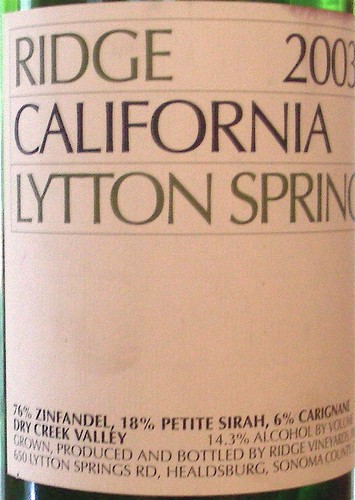 And we were far from running out of wine as it was time to open the magnum of 2003 Ridge Lytton Springs that our friend Pierre had brought.
And we were far from running out of wine as it was time to open the magnum of 2003 Ridge Lytton Springs that our friend Pierre had brought.
It's in 1972 that Ridge Vineyards started making its first Lytton Springs Zinfandel from 80 year old vines, and in the early 1990s, the winery was able to purchase the land. The place is named after "Captain" William Litton, the actual owner in the 1870s. It was later in the early 1900s that the spelling changed to Lytton.
The vineyard is located north of Sonoma County, in the hills that separate the Dry Creek and Alexander Valleys. It is mostly planted to Zinfandel — including some 111-year-old vines — as well as Petite Sirah, Carignane, a small amount of Mataro (Mourvèdre), and Grenache.
The wine had deep red color and a rich combination of red and black fruits on the nose. The palate had some good acidity and sweet berry aromas without being jammy at all. Overall, the wine was very well balanced, offering much more finesse than most. I was happy: I too rarely find a Zinfandel that I like.
Technorati tags: wine food & drink
She also showed us how to make turkey croquettes with leftover mashed potatoes. Simply served with a green salad, they were the ultimate comfort dish: crispy on the outside, moist and tasty on the inside.
 And we were far from running out of wine as it was time to open the magnum of 2003 Ridge Lytton Springs that our friend Pierre had brought.
And we were far from running out of wine as it was time to open the magnum of 2003 Ridge Lytton Springs that our friend Pierre had brought.It's in 1972 that Ridge Vineyards started making its first Lytton Springs Zinfandel from 80 year old vines, and in the early 1990s, the winery was able to purchase the land. The place is named after "Captain" William Litton, the actual owner in the 1870s. It was later in the early 1900s that the spelling changed to Lytton.
The vineyard is located north of Sonoma County, in the hills that separate the Dry Creek and Alexander Valleys. It is mostly planted to Zinfandel — including some 111-year-old vines — as well as Petite Sirah, Carignane, a small amount of Mataro (Mourvèdre), and Grenache.
The wine had deep red color and a rich combination of red and black fruits on the nose. The palate had some good acidity and sweet berry aromas without being jammy at all. Overall, the wine was very well balanced, offering much more finesse than most. I was happy: I too rarely find a Zinfandel that I like.
Technorati tags: wine food & drink
Subscribe to:
Posts (Atom)